Audio Mixing Boot Camp
Hands-On Basic Training for Musicians
-
Ships in 1 to 2 weeks
Details
Description
SKU: AP.37741
Hands-On Basic Training for Musicians. Composed by Bobby Owsinski. Books and DVDs; Method/Instruction; Pro Audio; Pro Audio Textbook; Reference Textbooks. Boot Camp. Book and Digital Download. 160 pages. Alfred Music #00-37741. Published by Alfred Music (AP.37741).ISBN 9780739082393. UPC: 038081422787. English.
If you're creating your first mix and don't know where to begin, or your mixes aren't as good as you'd like them to be, Audio Mixing Boot Camp is here to help. Built around a series of hands-on mixing exercises designed to show you how to listen and work like a pro, best-selling author Bobby Owsinski reveals the tips, tricks, and secrets to all the different facets of mixing, including instrument and vocal balance, panning, compression, EQ, reverb, delay, and making your mix as interesting as possible. You'll cut years off the time usually needed to become proficient in the art of mixing with this book, which is specifically designed to accelerate learning. See how the pros handle the critical balance between the bass and drums. Learn where, when, why, and how EQ should be used on virtually any instrument. Become proficient at using effects in just the right way for each particular mixing situation. And master the key to fat and punchy sounding mixes: compression. Audio Mixing Boot Camp also features an accompanying online media filled with lessons, templates, and examples specifically developed to take your mixing chops to the next level.
Song List (278)
- CHAPTER 13: THE FINAL MIX
- Glossary
- Bibliography
- Index
- Preface
- Welcome to the Audio Mixing Bootcamp
- CHAPTER 1: MONITORING
- The Listening Environment
- Determining the Listening Position
- Standing Waves
- Acoustic Quick Fixes
- Exercise Pod -- Improving the Listening Environment
- Basic Monitor Setup
- Exercise Pod -- Speaker Placement
- How to Listen
- Basic Listening Technique
- Exercise Pod -- What to Listen For
- How Loud (or Soft) Should I Listen?
- Exercise Pod -- Listening Levels
- Listening on Several Speaker Systems
- Exercise Pod -- Listening on Multiple Monitors
- Listening in Mono
- Phase Coherency
- Balances
- Exercise Pod -- Listening in Mono
- CHAPTER 2: SESSION SETUP
- Prepping Your Mix
- Make a Session File Copy
- Arrange Your Tracks
- Delete Empty Tracks
- Deactivate and Hide Unused Tracks
- Reorder Your Tracks
- Color-Code the Tracks
- Correctly Label the Tracks
- Insert Section Markers
- Set Up Subgroups
- Set Up Your Effects
- Assign the Channels
- Insert Compressors and Limiters
- Exercise Pod -- Prepping Your Mix
- Prepping Yourself
- Play Something You Know
- Take Notes
- Make Yourself Comfortable
- Exercise Pod -- Prepping Yourself
- CHAPTER 3: MIXING BASICS
- A Brief History
- Exercise Pod -- Identifying Different Recording Techniques and Eras
- What Are You Trying to Accomplish?
- Developing the Groove
- Exercise Pod -- Identifying the Groove
- Emphasizing the Most Important Elements
- Exercise Pod -- Identifying the Most Important Song Element
- Putting the Performers in an Environment
- Exercise Pod -- Identifying the Tall, Deep and Wide Dimensions
- What Does an Amateur Mix Sound Like?
- The 6 Elements of a Mix
- Exercise Pod -- The Elements of a Mix
- CHAPTER 4: BALANCE
- Visualize Your Mix
- Exercise Pod -- Visualize Your Mix
- The Musical Elements of an Arrangement
- Born This Way by Lady Gaga
- Power by Kanye West
- Grenade by Bruno Mars
- Exercise Pod -- Identifying Arrangement Elements
- Building the Mix
- The Drums
- Setting the Levels
- Exercise Pod -- Balancing the Drums
- Checking the Drum Phase
- Exercise Pod -- Checking the Drum Phase
- Assigning the Drums to a Group or Subgroup
- Exercise Pod -- Assigning the Drum Channels to a Subgroup
- The Bass
- Exercise Pod -- Balancing the Bass and Drums
- The Vocals
- Background Vocals
- Exercise Pod -- Balancing the Lead and Background Vocals
- Guitars
- Exercise Pod -- Balancing Guitars
- KEYBOARDS
- Piano
- Electric Piano
- Organ
- Synthesizers
- Exercise Pod -- Balancing the Keyboards
- Loops
- Exercise Pod -- Balancing Loops
- Mixing by Muting
- Automation
- CHAPTER 5: PANNING
- The Three Main Panning Areas
- Low Frequencies in the Center
- Panning the Drums
- Exercise Pod -- Panning the Drums
- Panning the Bass
- Exercise Pod -- Panning the Bass
- Panning Guitars
- Exercise Pod -- Panning Guitars
- Stereo Instruments
- Panning Keyboards
- Exercise Pod -- Panning the Keyboards
- Pseudo-Stereo
- Exercise Pod -- Pseudo-Stereo Panning
- Panning Vocals
- Exercise Pod -- Panning the Lead Vocals
- Exercise Pod -- Panning the Background Vocals
- CHAPTER 6: COMPRESSION
- Compression Basics
- Compressor Controls
- Ratio
- Threshold or Input
- Attack and Release
- Gain, Make-Up Gain or Output
- Gain Reduction Meter
- The Side Chain
- Bypass or In
- Compressor Operation
- Setting the Compressor
- How Much Compression Do I Need?
- Compression As an Effect
- Limiting
- Compressing the Various Instruments
- Compressing the Drums
- Exercise Pod -- Compressing the Drums
- Parallel Compression
- Compressing the Bass
- Exercise Pod -- Compressing the Bass
- Compressing Guitars
- Exercise Pod -- Compressing Electric Guitars
- Exercise Pod -- Compressing the Acoustic Guitar
- Compressing Keyboards
- Exercise Pod -- Compressing Keyboards
- Compressing Vocals
- Exercise Pod -- Compressing the Lead Vocal
- Compressing Other Instruments
- Compressing Loops
- Exercise Pod -- Compressing Loops
- De-essers
- Exercise Pod -- Using The De-esser
- GATES
- Exercise Pod -- Using a Gate
- CHAPTER 7: USING THE EQ
- Equalization Basics
- EQ Parameters
- A Description of the Audio Bands
- Using the Equalizer
- Subtractive Equalization
- Juggling Frequencies
- The Magic High-Pass Filter
- EQing Various Instruments
- Equalizing the Drums
- Exercise Pod -- EQing the Drums
- Equalizing the Bass
- Exercise Pod -- EQing the Bass
- Equalizing the Vocal
- Exercise Pod -- EQing the Vocal
- Exercise Pod -- EQing the Background Vocals
- Equalizing the Electric Guitar
- Exercise Pod -- EQing the Electric Guitar
- Equalizing the Acoustic Guitar
- Exercise Pod -- EQing the Acoustic Guitar
- Equalizing the Piano
- Exercise Pod -- EQing the Piano
- Equalizing the Organ
- Exercise Pod -- EQing the Organ
- Equalizing Strings
- Exercise Pod -- EQing the String Section
- Equalizing Horns
- Exercise Pod -- EQing Horns
- Equalizing Percussion
- Exercise Pod -- EQing Bongos and Congas
- Exercise Pod -- EQing Shakers and Triangle
- CHAPTER 8: ADDING REVERB
- Reverb Basics
- Typical Reverb Parameters
- The Major Parameter Controls
- Timing a Reverb to the Track
- Timing the Decay
- Exercise Pod -- Timing Reverb Decay
- Timing the Pre-Delay
- Exercise Pod -- Timing Reverb Pre-Delay
- Reverb Setup
- The Two-Reverb Quick-Setup Method
- The Three-Reverb Full-Setup Method
- Adding Reverb to Instruments
- Adding Reverb to the Drum Kit
- Exercise Pod -- Adding Reverb to the Drum Kit
- Adding Reverb to the Bass
- Exercise Pod -- Adding Reverb to the Bass
- Adding Reverb to the Vocal
- Exercise Pod -- Adding Reverb to the Lead Vocal
- Exercise Pod -- Adding Reverb to the Background Vocals
- Adding Reverb to Guitars
- Exercise Pod -- Adding Reverb to the Guitar
- Adding Reverb to Keyboards
- Exercise Pod -- Adding Reverb to the Piano
- Exercise Pod -- Adding Reverb to the Organ
- Exercise Pod -- Adding Reverb to Synthesizers
- Adding Reverb to Strings
- Exercise Pod -- Adding Reverb to the String Section
- Adding Reverb to Horns
- Exercise Pod -- Adding Reverb to Horns
- Adding Reverb to Percussion
- Exercise Pod -- Adding Reverb to Bongos and Congas
- Exercise Pod -- Adding Reverb to Shakers and Triangles
- Layering the Mix
- Exercise Pod -- Layering the Mix
- CHAPTER 9: ADDING DELAY
- Delay Basics
- Typical Delay Parameters
- The Haas Effect
- Timing the Delay to the Track
- Other Note Divisions
- Exercise Pod -- Timing the Delay
- Delay Setup
- The Single-Delay Quick-Setup Method
- The Three-Delay Full-Setup Method
- Adding Delay to Instruments
- Adding Delay to the Vocals
- Exercise Pod -- Adding Delay to the Vocals
- Adding Delay to the Guitar
- Exercise Pod -- Adding Delay to the Guitar
- Adding Delay to Keyboards
- Exercise Pod -- Adding Delay to Keyboards
- Adding Delay to the Drum Kit
- Exercise Pod -- Adding Delay to the Drum Kit
- Adding Delay to Other Instruments
- CHAPTER 10: MODULATION EFFECTS
- Modulation Basics
- Types of Modulation
- Flangers and Phasers
- Chorus
- Tremolo and Vibrato
- Parameter Settings
- Tremolo / Vibrato
- Modulation Setup
- Modulation on Instruments
- Modulation on Guitars
- Exercise Pod -- Modulation on Guitars
- Modulation on Keyboards
- Exercise Pod -- Modulation on Keyboards
- Modulation on Vocals
- Exercise Pod -- Modulation on Lead Vocal
- Exercise Pod -- Modulation on Background Vocals
- Modulation on Strings
- Exercise Pod -- Modulation on Strings
- Modulation on Other Instruments
- Exercise Pod -- Modulation on Drums
- CHAPTER 11: INTEREST
- Finding the Groove
- Exercise Pod -- Finding the Groove
- Establishing the Groove
- Exercise Pod -- Establishing the Groove
- Emphasizing the Most Important Element
- Finding the Most Important Element
- Exercise Pod -- Finding the Most Important Element
- Exercise Pod -- Emphasizing the Most Important Element
- Making a Mix Element Interesting
- Exercise Pod -- Making an Element Interesting
- CHAPTER 12: THE MASTER MIX
- Mixing with Subgroups
- Exercise Pod -- Mixing with Subgroups
- The Master Level Meters
- Types of Meters
- The VU Meter
- The Peak Meter
- Mix Bus Levels
- Exercise Pod -- Setting the Mix-Bus Levels
- Mix-Bus Compression
- Mix-Bus Compressor Settings
- Exercise Pod -- Setting Up the Mix-Bus Compressor
- Stay Away from Hypercompression!
- Exercise Pod -- The Evils of Hypercompression
- How Long Should My Mix Take?
- How to Know When Your Mix Is Finished
- Exercise Pod -- Am I Finished Yet?
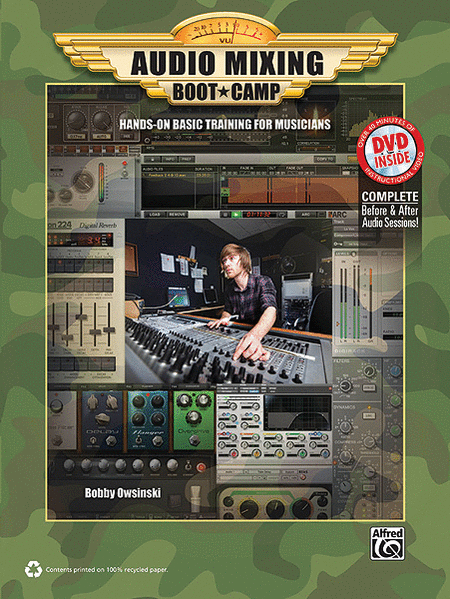
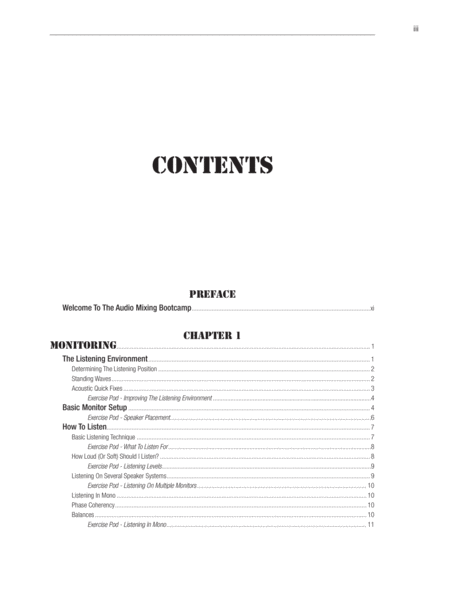
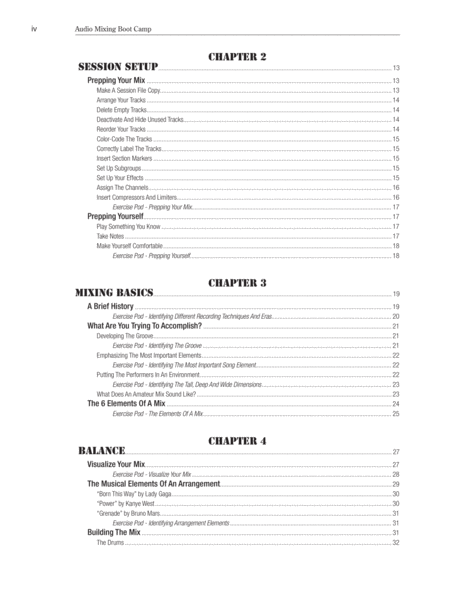
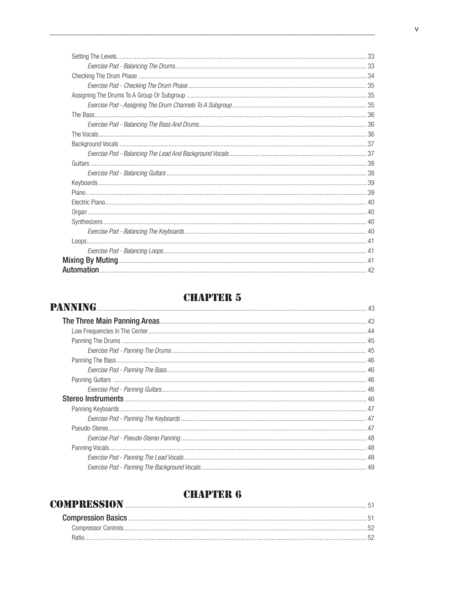
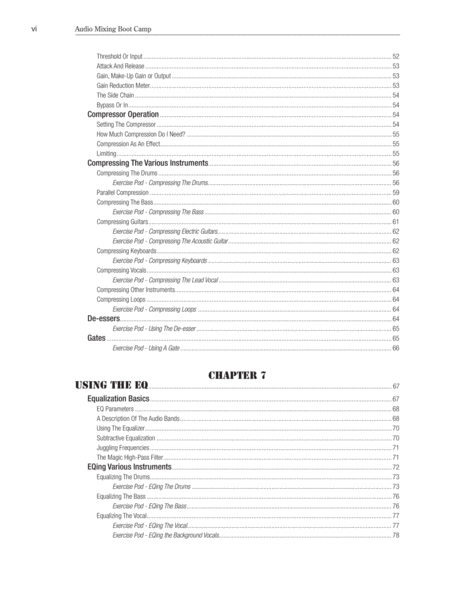
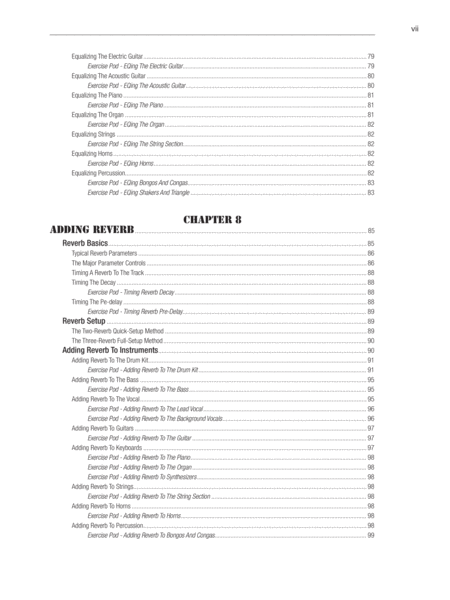
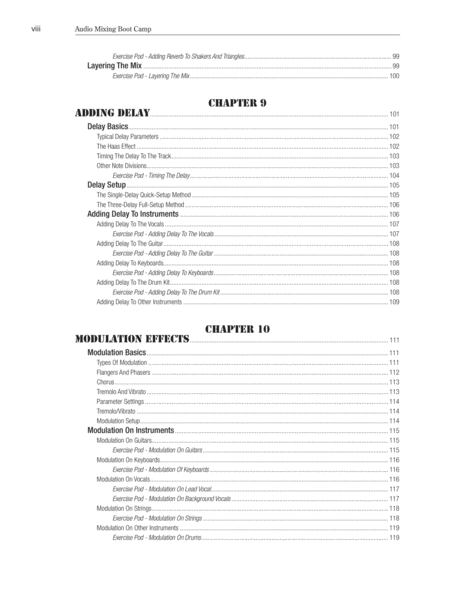
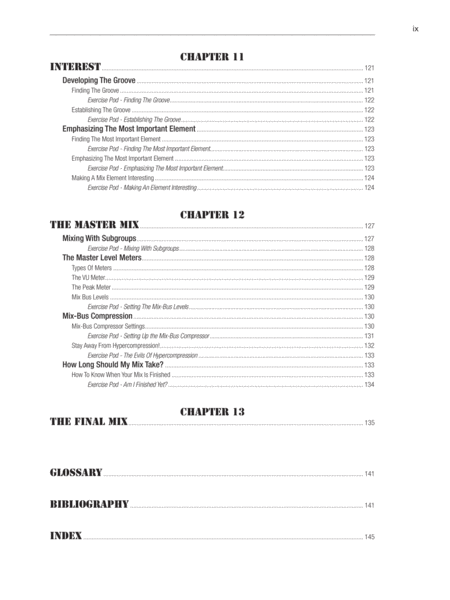
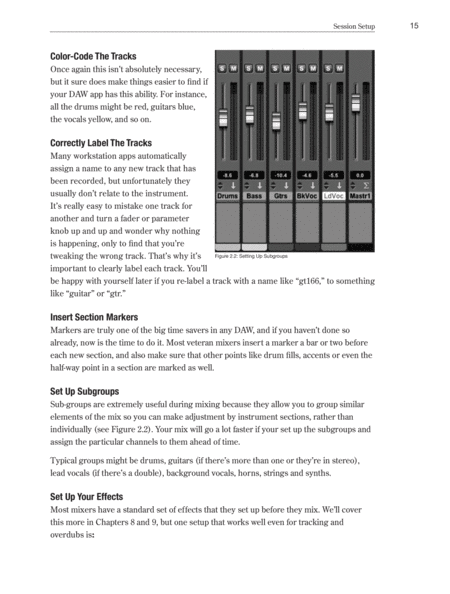
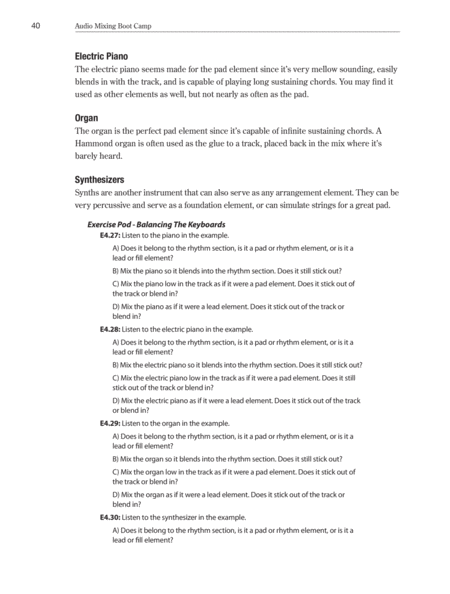
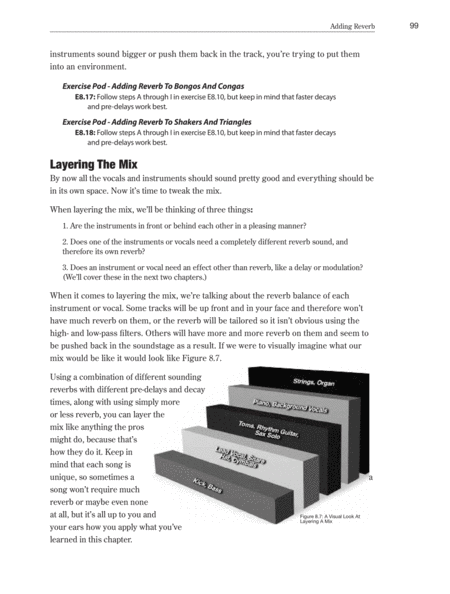
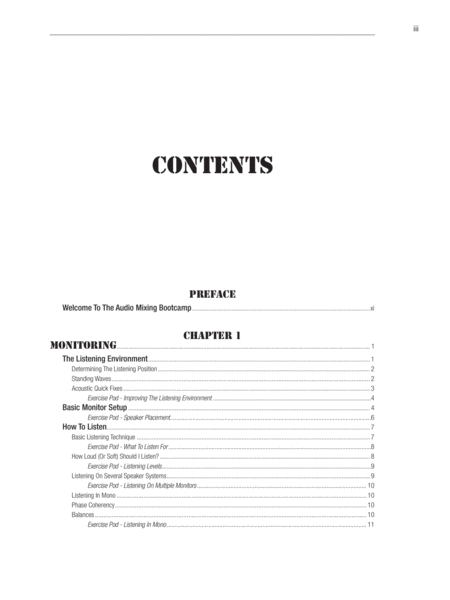
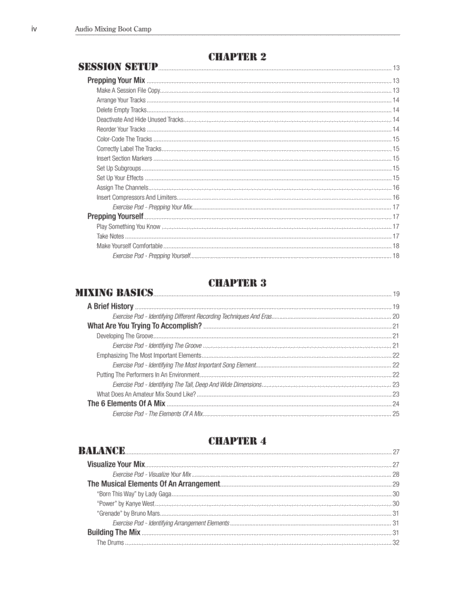
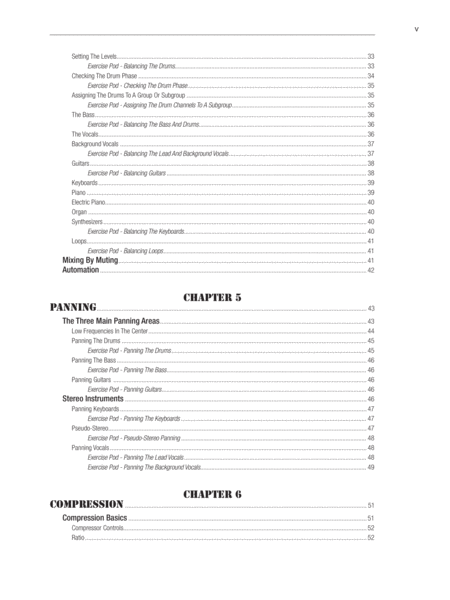
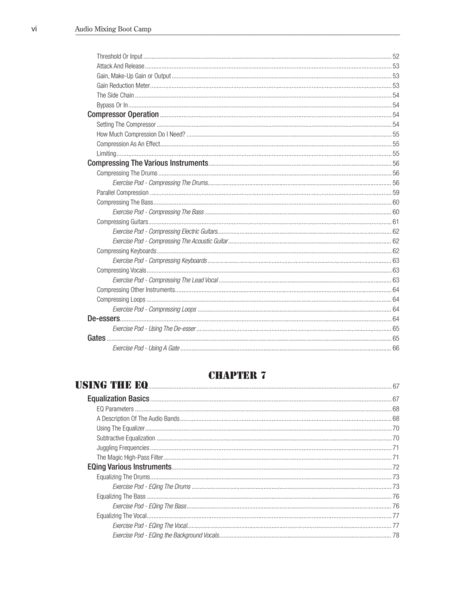
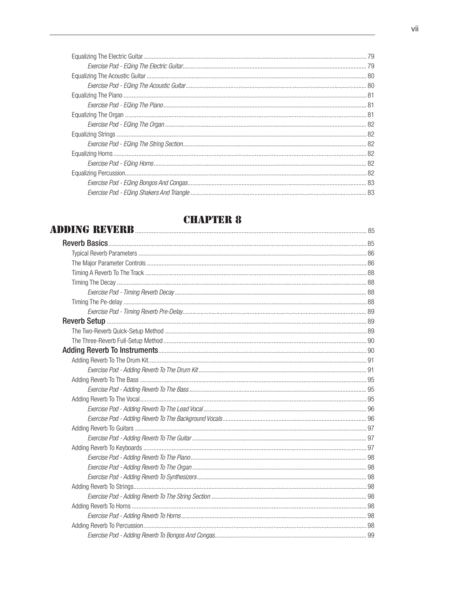
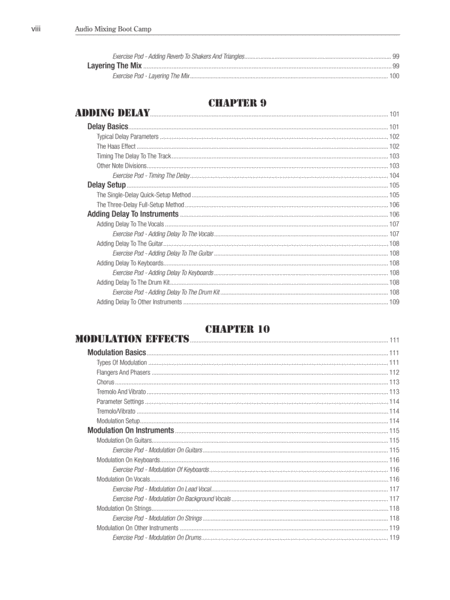
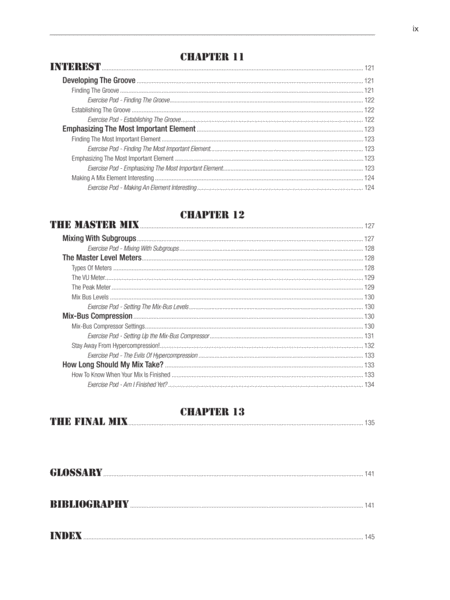
 Share
Share